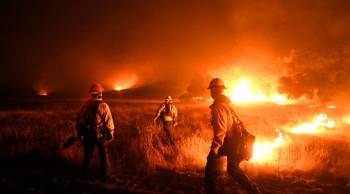
Wildfires are more frequent, getting worse — and straining government budgets
Wildfires are more frequent, getting worse — and straining government budgets

Fighting wildfires is expensive. Take those airplanes that fly over them and drop that red fire retardant.
“When I was a firefighter, I used to think that was the coolest thing. Now all I see is dollar bills flinging out of the bottom of the airplane,” said George Geissler, now the state forester in Washington.
Just one load of that fire retardant can cost up to $10,000. And the plane itself, he said, “could cost you $1,000 to $2,000, $3,000 an hour, just when the propellers are spinning.”
That’s a tiny fraction of the total cost of wildfires.
“Everybody sees the house that was burned down. But think about the cost of shutting down a highway on a fire. It’s millions of dollars per hour,” Geissler said. “Think about the impacts of smoke on communities. People don’t go out. The outdoor Shakespeare festival in Oregon was canceled, and it is millions of tourism dollars in this one small community.”
Plus, all the lost tax revenue that goes with it. There’s also the damage to natural resources in forests, which are home to the drinking water for many communities.
“Our watersheds are getting burned up,” Geissler said. “Water quality goes into the toilet — literally — and then what happens is you have to spend more money to purify water and prepare it for human consumption.”
As climate change makes wildfires more frequent and more destructive, all of these costs are rising, according to a new report from the Pew Charitable Trusts. And that’s affecting federal, state and local budgets.
Federal spending by the two main agencies that manage wildfires — the Department of the Interior and the Forest Service — has doubled in the last decade, Pew found.
“Spending data from states is more difficult to come by,” said Colin Foard, a lead author of the study. “But to give one example, Washington’s average annual spending on wildfires more than tripled when you compare the first half of the 2010s to the second half.”
Still, those numbers likely don’t give the full picture, which is complicated. There are so many different costs associated with fighting and recovering from wildfires and trying to prevent them, and they’re being borne by different agencies at different levels of government at different times.
“For many, many years and decades, really those other costs that come to the surface following a wildfire event have been overlooked,” said Kimiko Barrett, a wildfire researcher and policy lead at Headwaters Economics in Montana.
That’s starting to change. State and local government officials are talking more about the need to track and account for everything “with respect to damage and the costs that are associated — not just for suppression, but what we’re seeing with these rebuilding efforts,” Barrett said.
In many states, the increased costs are starting to put a strain on budgets more broadly because most of the money states spend on wildfires comes from the same pot they use to pay for everything else.
“So when a big fire happens, that’s inherently taking away from other priorities in the state budget on things that affect people’s everyday lives,” said Foard at Pew. “Things like human services, K-12 education, health care.”
That’s true of other climate-related disasters too, including hurricanes and floods. But disasters don’t affect all communities in the same way.
“There is very substantial social disparity in disaster recovery and responses,” said Qing Miao, professor of public policy at the Rochester Institute of Technology in New York state.
A recent study she worked on looking at county governments found that low-income communities tend to lose more tax revenue than wealthy communities after disasters. They also tend to get less state and federal aid.
“This might actually mean that local governments do not provide sufficient public goods and services following disasters because they have to compromise on their spending,” she said. “The current system does not seem to really support their recovery.”
Low-income communities also tend to get less federal funding for mitigation projects that would make them less vulnerable to future disasters.
The first step in changing that, Miao said, is knowing more about how much governments are actually spending and where the money’s going.
There’s a lot happening in the world. Through it all, Marketplace is here for you.
You rely on Marketplace to break down the world’s events and tell you how it affects you in a fact-based, approachable way. We rely on your financial support to keep making that possible.
Your donation today powers the independent journalism that you rely on. For just $5/month, you can help sustain Marketplace so we can keep reporting on the things that matter to you.


















